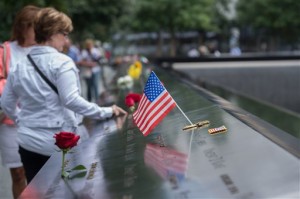Michael Arad, designer of the 9/11 memorial, marked the anniversary of the attacks by addressing the Orem/Provo community at Utah Valley University.

“When I turned on the radio and heard that the World Trade Center had been stuck by a plane, I thought it was an accident, not a premeditated act of terror. I walked up to the rooftop of our apartment building to get a better view and I saw the second plane coming down south the Hudson Bank and fly in to the second tower. I immediately knew that it was no accident,” said Michael Arad at a keynote address given at UVU Friday, Sept. 11th.
Arad is an Israeli-American architect that lived in Manhattan, New York for three years with his wife, but never felt like he was a true New Yorker until that day.
“Witnessing the attacks firsthand really changed my relationship with the city and my understanding of who I was,” Arad said.
It was only a matter of time after finding his wife and returning home that the unbelievable happened, the two towers crumbled to the ground.
Arad said that the attacks affected him deeply, and he felt the need to respond and commemorate what New Yorkers witnessed that day. With a Master’s degree from the Georgia Institute of Technology’s College of Architecture, he committed to designing a memorial that would later be selected among over 5,000 design submissions internationally.
“I had this image in my head of two empty spaces in the Hudson River with the river flowing into them, but never filling them up,” explained Arad, his master plan revolved around creating a public space that captured a sense of absence, a place where residents and visitors alike could come together and never forget that fateful day.
Arad said the process of designing the monument was difficult, but informative and emotional. He worked closely with families of the victims, making sure every name was carefully placed, and met every family request.
One request particularly painted a clear picture of care and detail used for every name, Arad told the story of a father who rode the same plane that crashed into the building of his daughter’s workplace. Both names were placed together.

Arad is one of several Americans who memorialized this day, but he was not alone.
On BYU campus, 9/11 proved to be a day of piety, patriotism and a day of religious sympathy, according to Naomi Schaefer Riley, a Columnist for the New York Daily Post and Author of the book “God on the Quad.”
In her book, she mentioned her experience on campus when the two Boeing airplanes collided into the World Trade Center Towers.
“Anti-American sentiment is almost non-existent at BYU,” Riley wrote.
She mentioned that while 146 colleges in 36 states rallied against U.S government and military forces, 20,000 BYU students attended the Tuesday devotional to “recite the pledge of allegiance, recite a prayer and listen to President Bateman speak.”
Riley’s book noted that in the days that followed, students sang the Star Spangled Banner and many ROTC students wore their uniforms to class as a form of patriotism.
“Patriotism at BYU derives directly from the church and its teachings,” said Damon Linker, a former BYU teacher of political philosophy and current correspondent at TheWeek.com. “The U.S exists [in Mormon view] so that the Latter Days Saints can have safe haven in the world.” Linker also correlated patriotism as a form of service to God.
President George W. Bush said to the United Nations General Assembly in New York directly after the incident, “Time is passing. Yet, for the United States of America, there will be no forgetting September the 11th.
“We will remember every rescuer who died in honor. We will remember every family that lives in grief. We will remember the fire and ash, the last phone calls, the funerals of the children.”




